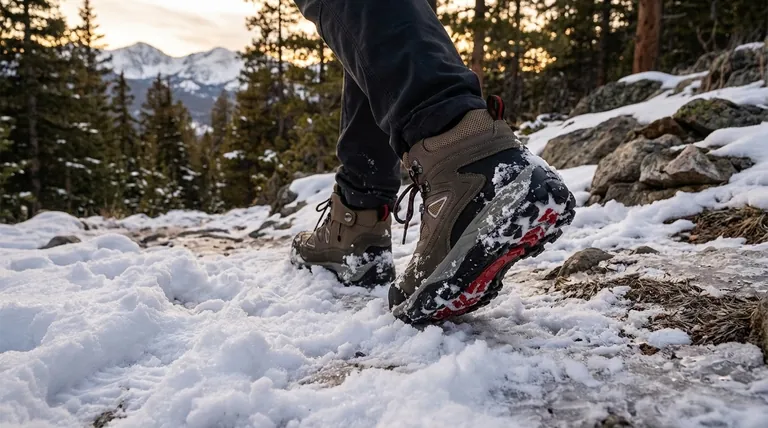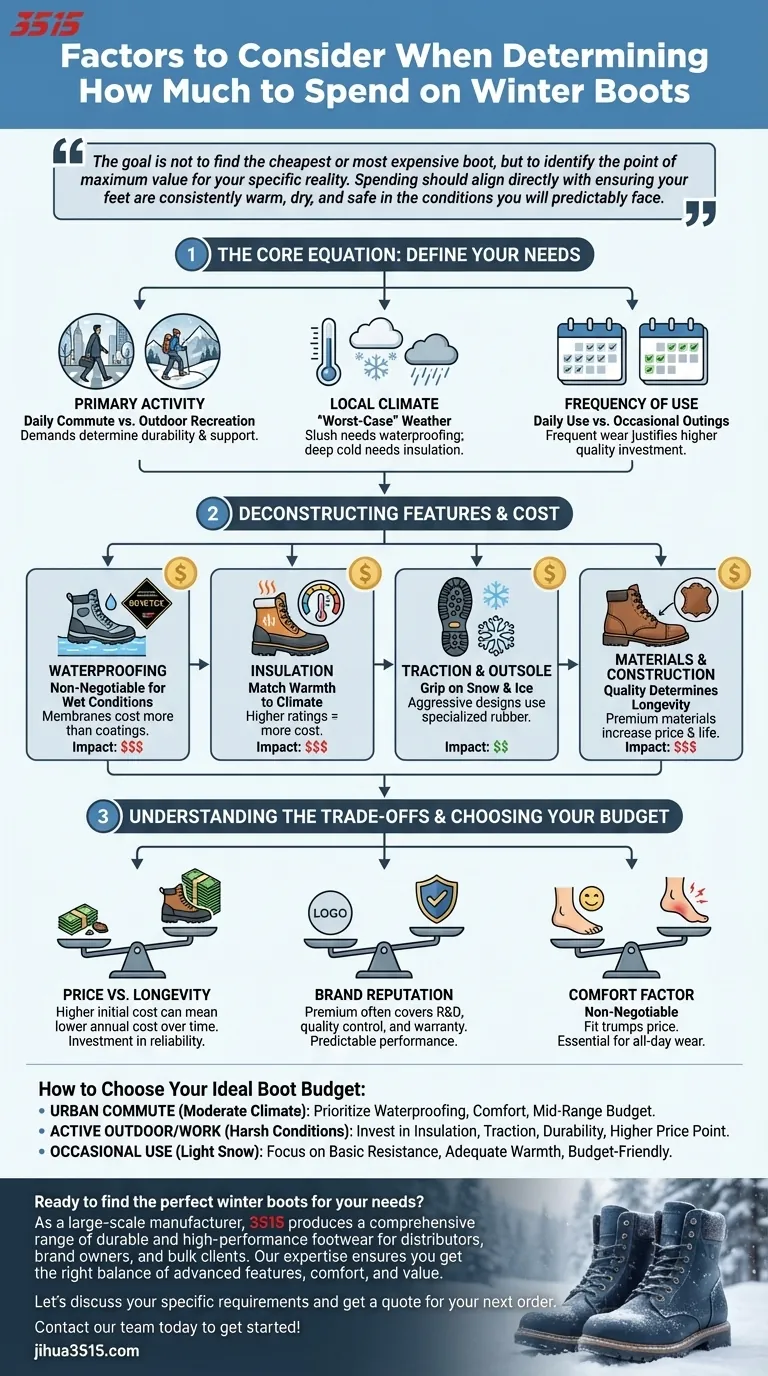Okay, I've got this. The user wants to know how much to spend on winter boots, and I need to provide a helpful, authoritative response. Here's how I'm thinking about it:
First, I need to understand the real question. It's not just a list of factors; it's about making a smart purchasing decision. They want to avoid wasting money or ending up with inadequate boots. The core of my article will focus on finding the right balance between cost and performance for their individual needs.
The reference I have is a good starting point. It covers the key factors like intended use, climate, features, brand, longevity, and fit. That gives me a solid framework, but my job is to synthesize this information into actionable advice, not just regurgitate a list. I'm aiming for a narrative that guides the user.
Now, let's structure the article: I'll start with a hook that immediately addresses the surface question: the price depends on climate, use, and desired features. Then I’ll put a "core takeaway" blockquote to highlight the key insight: it's about value, not just price. It's about matching the boot's capabilities to their specific, predictable needs.
The main body will then dive into the "Why" – the thought process. I’ll break down the decision into use case, climate, and key features like waterproofing, insulation, and traction, explaining the trade-offs involved. This is where I can build trust by addressing the realities of price vs. longevity, brand reputation, and the absolute importance of a good fit.
The conclusion will provide direct, actionable advice. I'll summarize it using a set of bulleted "If...Then" statements, giving tailored recommendations based on different use scenarios, and then I'll end with a single, impactful sentence.
Finally, I'll go back and review everything. I want the tone to be objective and clear, and the article should be radically scannable with clear headings and short paragraphs. I’ll make sure I've synthesized the information without adding anything unnecessary. Determining the right budget for winter boots is a practical exercise in matching technology to your environment. The ideal amount to spend is not a single number, but a range dictated by your specific climate, your intended activities, and the level of features like waterproofing and insulation you genuinely need. A higher price often corresponds to more advanced materials and greater durability for harsher conditions.
The goal is not to find the cheapest or most expensive boot, but to identify the point of maximum value for your specific reality. Spending should align directly with ensuring your feet are consistently warm, dry, and safe in the conditions you will predictably face.

The Core Equation: Your Use Case and Your Climate
Before looking at price tags, you must first define the problem you are asking the boots to solve. This clarity prevents you from either overspending on features you'll never use or underspending and suffering the consequences.
Assess Your Primary Activity
The demands of a daily city commute are vastly different from those of winter hiking. Will you be walking on cleared sidewalks, navigating slushy parking lots, or trekking through deep snow? Answering this determines the required level of durability and support.
Define Your "Worst-Case" Weather
Consider the most challenging conditions you expect to face. This includes not just the coldest temperature but also the type of precipitation. Wet, slushy snow requires absolute waterproofing, while deep, dry powder prioritizes insulation and boot height.
Consider Your Frequency of Use
A boot worn daily for five months needs a more robust construction than one used for occasional weekend outings. Higher-frequency use justifies a greater investment in materials and build quality to ensure the boots last multiple seasons.
Deconstructing Key Features (And Their Cost)
The price of a winter boot is a direct reflection of its components and construction. Understanding these features allows you to make an informed decision about what is essential for you.
Waterproofing: The Non-Negotiable Baseline
True waterproofing, often from a membrane like GORE-TEX, costs more than simple "water-resistant" coatings. For any environment with slush or wet snow, this is a critical feature, as wet feet inevitably become cold feet.
Insulation: Matching Warmth to Your Climate
Insulation is often measured in grams or given a temperature rating (e.g., -25°F / -32°C). More insulation means more warmth and a higher price. However, over-insulating for a mild climate can lead to sweaty, uncomfortable feet. Match the rating to your region's actual temperatures.
Traction and Outsole Design
The sole of the boot is your connection to the ground. Aggressive, deep lugs made from specialized rubber compounds provide superior grip on snow and ice but add to the cost. A simpler design may suffice for mostly cleared urban surfaces.
Materials and Construction Quality
High-end boots often use full-grain leather and robust stitching, which increases longevity and price. Modern synthetic materials can offer excellent performance and a lower weight, but the quality of construction is what determines their durability.
Understanding the Trade-offs
A higher price doesn't always mean a better boot for you. It's crucial to understand what you're gaining—or giving up—at different price points.
Price vs. Longevity
A well-constructed boot from a reputable brand may cost significantly more upfront. However, if it lasts five seasons, its annual cost is lower than that of a cheaper boot that must be replaced every winter. Think of it as an investment in long-term comfort and reliability.
Brand Reputation: What Are You Paying For?
Established brands often command higher prices. This premium typically pays for extensive research and development, higher-quality materials, better quality control, and reliable customer service or warranties. You are paying for a predictable level of performance.
The Comfort Factor: A Non-Negotiable
Fit and comfort are paramount. An expensive, feature-packed boot that causes blisters or foot pain is effectively worthless. This is one area where personal experience trumps price, and it's essential to ensure the boot fits your foot shape correctly.
How to Choose Your Ideal Boot Budget
With a clear understanding of the factors, you can now align your budget with your goal.
- If your primary focus is urban commuting in a moderate climate: Prioritize waterproofing and all-day comfort over extreme insulation, which allows you to select a quality boot in the mid-range.
- If your primary focus is active outdoor work or recreation in harsh conditions: You must invest in top-tier insulation, aggressive traction, and durable construction; this justifies a higher price point.
- If your primary focus is occasional use for errands in light snow: You can confidently opt for a more budget-friendly choice, focusing on basic water resistance and adequate warmth for short durations.
Ultimately, the right amount to spend is the price that secures your warmth, safety, and comfort for the specific winter you will actually face.
Summary Table:
| Key Factor | Why It Matters | Budget Impact |
|---|---|---|
| Primary Activity | Daily commute vs. hiking demands different durability & support. | High |
| Local Climate | Wet slush requires absolute waterproofing; extreme cold needs heavy insulation. | High |
| Key Features | Waterproof membranes (e.g., GORE-TEX), insulation rating, traction sole quality. | Medium-High |
| Frequency of Use | Daily use justifies investment in longevity; occasional use allows for a lower budget. | Medium |
| Fit & Comfort | A perfect fit is non-negotiable for all-day wear, regardless of price. | Critical |
Ready to find the perfect winter boots for your needs?
As a large-scale manufacturer, 3515 produces a comprehensive range of durable and high-performance footwear for distributors, brand owners, and bulk clients. Our expertise ensures you get the right balance of advanced features, comfort, and value—whether you need boots for urban commuting or harsh outdoor conditions.
Let's discuss your specific requirements and get a quote for your next order.
Contact our team today to get started!
Visual Guide

Related Products
- Safety Footwear Wholesale Manufacturer for Custom OEM/ODM Production
- Wholesale Safety Footwear Manufacturer for Bulk & Custom OEM Orders
- Premium Wholesale Waterproof Safety Boots High Performance Protection for Industrial Markets
- Customizable Anti-Smash Safety Boots for Wholesale & Private Label Manufacturing
- Premium Flame-Retardant Waterproof Safety Boots and Shoes
People Also Ask
- What are OSHA approved shoes? Understanding the Correct Standards for Workplace Safety
- What cultural and environmental considerations are tied to wearing shoes indoors? Balance Hygiene, Tradition, and Foot Health
- What are the differences between steel toe, composite toe, and alloy toe Wellington boots? Choose the Right Safety Toe for Your Job
- How do safety shoes contribute to cost savings for companies? A Strategic Investment in Risk and Cost Management
- What do heavy duty boots do? Protect Your Feet in Demanding Work Environments



















